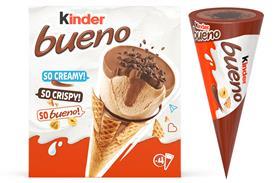Honey has bounced back and jams are thriving as premium lines, but the Brits aren’t mad on marmalade says Jackie Mitchell
Honey sales have squeezed past marmalade’s for the first time to take second place behind jam in jam, marmalade & honey overall.
With value sales of £58.29m, honey surpassed marmalade sales by £250,000 [TNS Superpanel 52 w/e November 4 2004]. Sales of honey soared 12% on last year, while figures for marmalade remain static.
The growth for honey can be attributed to a combination of volume increase (up 4% year-on-year) and price inflation of 8%. Prices increased following the China honey crisis when low levels of the banned antibiotic cholaramphericol were found in the Chinese product in 2002. At the time, Chinese honey accounted for a third of all honey sold in the UK when imports were banned.
However, Paul Ardron, general manager for Premier Foods’ spreads business unit, which owns the Gale’s honey brand, is downbeat about the current picture. “I wouldn’t say honey has been a success story,” he says. “In the past two years, the price has gone up and although the figures show honey has grown, the number of consumers has fallen - they’ve just had to pay more. So I don’t think we can kid ourselves that honey is as exciting and robust as the figures show.”
But Stuart Bailey, MD of Rowse Honey, believes there are even better days ahead: “We have been able to recover some of the margin and put money into promotions, evident in price reductions.”
As for marmalade, the problem is, according to TNS Superpanel, that the preserve is popular in older households and shunned by the younger generations - 82% of sales are purchased by people aged over 45. In fact, women over 65 consume more marmalade than the total amount of honey and jam consumed by the under-16s.
At Asda, marmalade sales continue in single digit decline “aided by the continued reduction in the breakfast eating occasion as well as the changing habits of those consumers who do eat breakfast,” says Louise Bennett, buyer for desserts and baking. “The growth of bagels and cereal bars as convenient alternatives to toast have not helped sales.”
Premier Foods’ Ardron puts the blame on marmalade manufacturers not doing enough to attract new consumers. “The only innovations have been old-fashioned marmalade - thick
cut or with whisky,” he says. “That was our thinking behind Hartley’s Fresh marmalade - we took a fresh approach and after 10 months, it’s doing well.”
Judith Sinclair-Smith, category buyer at the Co-operative Group, says confusion at the fixture is the biggest deterrent to customer purchase of marmalade. “The Co-op has taken the initiative to divide marmalade into jelly marmalade, light, dark and non-orange and have a brand leader and an own label offer (where appropriate) in each classification.
“Reflecting our strategy on jam and focusing on the premium offer, we expect this to deliver the exceptional results we have seen on jam over the last three years.”
Jam remains the major player in the sector, worth £88.86m in value with sales growth of 6%. Standard jam accounts for 48.4% of total jam sales.
Within this category, premium jam holds a 33.4% share and is driving growth with more than 430,000 new households buying into this sector during the last year [TNS Superpanel].
The star performer in the category is Hartley’s Best, growing by 12.5% year-on-year [ACNielsen MAT October 30, 2004]. It is now the number one brand [TNS Superpanel], having overtaken Robertson’s, now in second place.
Premier Foods’ Ardron says he is delighted with this news. “Consumers were tired of old-fashioned brands including Hartley’s, which is more than 100 years old.
“So we needed to reinvigorate the brand with a new recipe, brand and logo. We needed to bring new consumers into the category which was dominated by older brands.”
Premier Foods launched a new range of Hartley’s luxury conserves in six varieties last month, which are already listed at Sainsbury. “We want to bring something new into the market,” adds Ardron.
Elsewhere on the fixture, peanut butter is worth a significant £27.4m, but sales have declined by 3.2% over the last year [ACNielsen MAT w/e October 30 2004], though according to Ardron, a quarter of the population eats peanut butter. Premier Foods acquired the £9.5m Sun-Pat brand 18 months ago and to revitalise the brand it introduced Super Smooth and Extra Crunchy variant in January 2004.
Ardron says sales are doing well but “you have to be patient with new products in the market - consumers don’t buy into the category as frequently as you would like”.
Premier Foods plans to also invest in multi-brand promotions, which are likely to work across Premier’s Sun-Pat and Gale’s honey brands.
Honey sales have squeezed past marmalade’s for the first time to take second place behind jam in jam, marmalade & honey overall.
With value sales of £58.29m, honey surpassed marmalade sales by £250,000 [TNS Superpanel 52 w/e November 4 2004]. Sales of honey soared 12% on last year, while figures for marmalade remain static.
The growth for honey can be attributed to a combination of volume increase (up 4% year-on-year) and price inflation of 8%. Prices increased following the China honey crisis when low levels of the banned antibiotic cholaramphericol were found in the Chinese product in 2002. At the time, Chinese honey accounted for a third of all honey sold in the UK when imports were banned.
However, Paul Ardron, general manager for Premier Foods’ spreads business unit, which owns the Gale’s honey brand, is downbeat about the current picture. “I wouldn’t say honey has been a success story,” he says. “In the past two years, the price has gone up and although the figures show honey has grown, the number of consumers has fallen - they’ve just had to pay more. So I don’t think we can kid ourselves that honey is as exciting and robust as the figures show.”
But Stuart Bailey, MD of Rowse Honey, believes there are even better days ahead: “We have been able to recover some of the margin and put money into promotions, evident in price reductions.”
As for marmalade, the problem is, according to TNS Superpanel, that the preserve is popular in older households and shunned by the younger generations - 82% of sales are purchased by people aged over 45. In fact, women over 65 consume more marmalade than the total amount of honey and jam consumed by the under-16s.
At Asda, marmalade sales continue in single digit decline “aided by the continued reduction in the breakfast eating occasion as well as the changing habits of those consumers who do eat breakfast,” says Louise Bennett, buyer for desserts and baking. “The growth of bagels and cereal bars as convenient alternatives to toast have not helped sales.”
Premier Foods’ Ardron puts the blame on marmalade manufacturers not doing enough to attract new consumers. “The only innovations have been old-fashioned marmalade - thick
cut or with whisky,” he says. “That was our thinking behind Hartley’s Fresh marmalade - we took a fresh approach and after 10 months, it’s doing well.”
Judith Sinclair-Smith, category buyer at the Co-operative Group, says confusion at the fixture is the biggest deterrent to customer purchase of marmalade. “The Co-op has taken the initiative to divide marmalade into jelly marmalade, light, dark and non-orange and have a brand leader and an own label offer (where appropriate) in each classification.
“Reflecting our strategy on jam and focusing on the premium offer, we expect this to deliver the exceptional results we have seen on jam over the last three years.”
Jam remains the major player in the sector, worth £88.86m in value with sales growth of 6%. Standard jam accounts for 48.4% of total jam sales.
Within this category, premium jam holds a 33.4% share and is driving growth with more than 430,000 new households buying into this sector during the last year [TNS Superpanel].
The star performer in the category is Hartley’s Best, growing by 12.5% year-on-year [ACNielsen MAT October 30, 2004]. It is now the number one brand [TNS Superpanel], having overtaken Robertson’s, now in second place.
Premier Foods’ Ardron says he is delighted with this news. “Consumers were tired of old-fashioned brands including Hartley’s, which is more than 100 years old.
“So we needed to reinvigorate the brand with a new recipe, brand and logo. We needed to bring new consumers into the category which was dominated by older brands.”
Premier Foods launched a new range of Hartley’s luxury conserves in six varieties last month, which are already listed at Sainsbury. “We want to bring something new into the market,” adds Ardron.
Elsewhere on the fixture, peanut butter is worth a significant £27.4m, but sales have declined by 3.2% over the last year [ACNielsen MAT w/e October 30 2004], though according to Ardron, a quarter of the population eats peanut butter. Premier Foods acquired the £9.5m Sun-Pat brand 18 months ago and to revitalise the brand it introduced Super Smooth and Extra Crunchy variant in January 2004.
Ardron says sales are doing well but “you have to be patient with new products in the market - consumers don’t buy into the category as frequently as you would like”.
Premier Foods plans to also invest in multi-brand promotions, which are likely to work across Premier’s Sun-Pat and Gale’s honey brands.













No comments yet